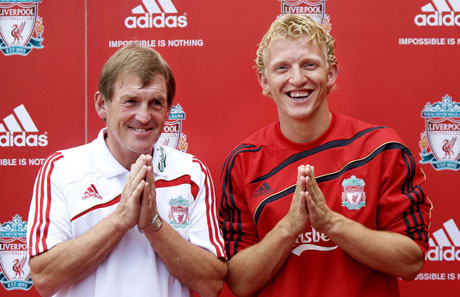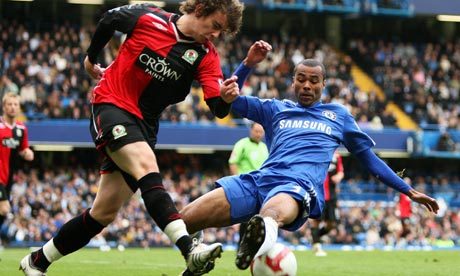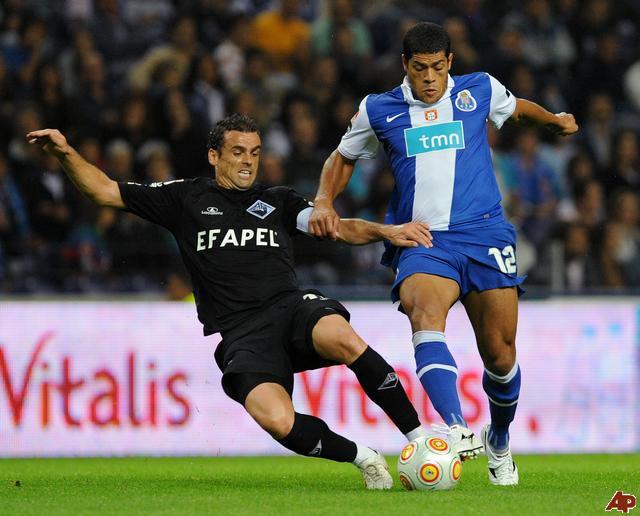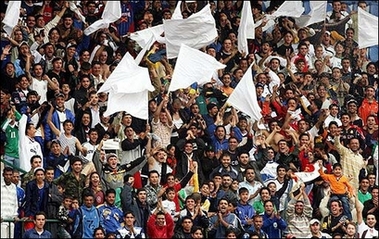-
Recent Articles
3 at the back and the 4-4-2 Diamond
 Last week Chelsea v Liverpool became the biggest tactical talking point of the season. Liverpool revived the the 3 man defence that Kenny debuted against Stoke. While with the introduction of Torres for £50m...
Last week Chelsea v Liverpool became the biggest tactical talking point of the season. Liverpool revived the the 3 man defence that Kenny debuted against Stoke. While with the introduction of Torres for £50m...How To Set Up A Back Four
 Last year, I wrote a guide about how to play a simple 4-4-2. One of the major components of that is the back four. In fact, most modern formations build upon four defenders; two full backs and two centre...
Last year, I wrote a guide about how to play a simple 4-4-2. One of the major components of that is the back four. In fact, most modern formations build upon four defenders; two full backs and two centre...Building Your Defence: Full Backs
 The modern full back is quickly becoming one of the most important players on the team sheet, infact even back in the days of Brian Clough, fat ed' argued that because of the space these players get in the final...
The modern full back is quickly becoming one of the most important players on the team sheet, infact even back in the days of Brian Clough, fat ed' argued that because of the space these players get in the final...False Nine Tactics
 When we think about modern football trends, we think about the fall of the 4-4-2, the introduction of inverted wingers and the rise of the 4-5-1. But there is one other tactical rise that seems to have...
When we think about modern football trends, we think about the fall of the 4-4-2, the introduction of inverted wingers and the rise of the 4-5-1. But there is one other tactical rise that seems to have...An Open Letter To The Football Manager Community
 To view Sports Interactive's response, click here FM-Britain will no longer be producing regular content. Sports Interactive have objected to our content model of charging for annual strategy guides,...
To view Sports Interactive's response, click here FM-Britain will no longer be producing regular content. Sports Interactive have objected to our content model of charging for annual strategy guides,...
JOIN 12,143 READERS - SUBSCRIBE NOW TO OUR FOOTBALL MANAGER NEWSLETTER
Get the latest FM news & best community content delivered directly to your e-mail inbox!
Tactical Theorems &Frameworks ’09: Closing Down & Passing Patterns
Written by: Richard Claydon
Category: Strategy
Posted on: November 23, 2008
November 23, 2008
Closing Down
Closing down translates as how quickly and how far a player will leave his defensive position to deal with an attacking threat. Setting it too high throughout the team will lead to defensive structure disintegrating as players chase their opponents all over the pitch. It will also result in a lot of tired legs and defensive errors during the latter stages of a match. Setting it too low will see players backing off and backing off, allowing the opposition time and space to make through passes and set up for shots in dangerous positions.
Generally, closing down will work best if players perform it in relation to their position. Forwards are positioned high up the pitch, so need to close down more aggressively than their defensive counter-parts. Midfielders will be somewhere between the two. With this in mind, it is advisable to use your goalkeeper and central defensive pairing as a base and grade upwards from there. For lower level, poorly conditioned and ill-disciplined squads you should veer towards the lower end of the closing down spectrum. For quality, hard working, fit and disciplined sides, you should veer towards maximum settings.
Using the DC’s mentality as a base (x), closing down should roughly conform to the following minimum to maximum settings:
• GK/DC: x
• FB/WB: x + 1 to x + 4
• DMC/MCd: x + 2 to x + 6
• MCa/AMC/Wingers: x + 3 to x + 8
• FCs: x + 4 to x + 10
As highlighted above, when choosing the correct settings for your team, it is important to recognise whether the closing down structure is too aggressive for the type of football your players, in terms of fitness, tactical discipline and technique, are capable of playing. A key indicator that closing down is too high is seeing your players running around like headless chickens and finishing games in a state of semi-exhaustion. This is likely to be quite common for high pressing tactics in lower level football. If you notice your players, either individually or as a unit, closing down to the extent that your defensive formation shape suffers, reduce individual closing down settings until you are happy with performance. Alternatively, you might decide to play a more cautious game or conserve player energy in easy matches, which will also require the reduction of closing down. The indicator that you have gone too low is seeing the opposition having time and space in front of the back line to pick their through balls and compose themselves to make consistently effective long range shots. In more defensive systems, you might have to apply more closing down than the guidelines suggest, especially for central midfielders with a low work rate.
It is also important to recognise the distinct closing down patterns in different footballing cultures, with sides from hotter countries more focused on conserving energy than pressing the opposition at pace. In contrast, colder countries generally employ far higher levels of closing down.
Pitch size will also play a factor. On a huge pitch, players will have to run much further to close down the opposition, so are less likely to get there in time for the instruction to be effective. They will also tire rapidly. On such a pitch, the closing down gradient needs to be gradual, with the whole team having very similar settings and targeting a certain area of the pitch to try and win back possession. On a small pitch, high closing down settings can majorly restrict the opposition’s chances of playing possession-orientated football. The closing down gradient will be steep, with the forwards having far greater settings than the central defenders, with attempts to regain possession happening all over the pitch. Think about what level of closing down best suits your players when deciding upon pitch size. However, wherever you play and at whatever level, it is important to maintain some degree of grading.
Passing Patterns
There are two major areas to be thinking about when setting passing patterns. The first is to make sure each player has plenty of passing options when he is in possession. The second is to think about what type of football you would like your team to play.
Passing Options
Passing length determines the options that a player will look for. Too short, and players won’t have enough free options within range, leading to the player getting confused and hoofing the ball clear. Too long and the player will tend to play too many speculative, Hollywood balls, making it difficult to hold onto possession. At the bare minimum, a player should always be able to look up and see two easy passing options. Ideally, there will be three but this might be difficult to achieve on small pitches, against entrenched defences or under heavy pressure. A common error is to allow a player no obvious forward passing options at all. If you ask a full back to play very short passes to an aggressive midfield, all of whom are looking to get forward at every opportunity, the chances are he will look up and fail to see an obvious pass. He will be able to pass it inside, but that will not initiate an attack and often leads to the back four being dispossessed by a pressing front line or punting a directionless long ball up field to avoid being caught in a dangerous position. Common signs that this is happening are players dawdling on the ball when under little pressure or players with short passing instructions banging it long.
Make sure that each defensive player can look up and hit a lateral ball, forward ball and a diagonal ball without too much difficulty. For a player high up the pitch, the forward ball might be very difficult to pick against a packed defence, so he needs to have lateral, diagonal and backwards options, which enable the team to retain possession and look for a new opening. Check on the positioning settings of the players around the passer (mentality and forward runs) and adjust his passing instructions so he can hit passes to any of the required lengths. That might mean giving him longer passing instructions than you would have first expected. Individual player attributes are influential when assigning passing instructions. A player of great passing ability should find some kind of passing option no matter his instructions, as long as his temperament is up to his being able to play his way out of danger. However, someone who struggles to control his passing might be better suited to longer ‘clear the ball’ instructions so that he doesn’t make poor, hurried passes from dangerous positions.
Passing Systems
Although all passing systems can and should be tweaked to best suit the players at your disposal, there are two basic passing strategies from which you can build. One is focused on keeping possession, controlling the ball and breaking down the opposition in the final third. The other is more counter-attacking orientated and looks to clear the lines before catching a retreating defence out of position and vulnerable to the quick break.
Possession/Breaking Down the Opposition: Such a system requires a solid base from which to launch attacks. It is the job of the defenders to ensure possession is retained until a chance opens. Hence, defenders and more defensively minded midfielders should be looking to play possession-friendly short passes. The more creative players will be looking to move the opposition about and open up space in the final third. Hence, they will be playing a far more direct game. If they lose the ball and it is cleared, the defence reorganize, reset the base and the move can start again.
Counter-Attacking: This system requires the opposite approach. The defence is expected to be under pressure and its main aim is to clear the lines and, hopefully, initiate a counter while doing so. Hence, defenders’ passing settings will be direct, looking to bypass the midfield and feed the forwards, as a short pass to a deep-lying midfielder can be extremely dangerous if he is immediately closed down and loses possession. Direct passing instructions ensures the whole team is in passing range for an under pressure defender, offering multiple clearance options. The forwards’ job is to try and counter before the opposition gets its defence back into position. Hence, they will be looking to play short passes to their strike partner and supporting midfielders in the hope of quickly working a good through ball opportunity.
The above systems will need to be adapted to pitch size and match strategy. For example, on a smaller pitch, the direct passes of the attacking players might be over hit too often and need to be adjusted accordingly. Likewise, to see out a match with a possession mindset might lead to a manager asking a second central midfielder to play short passes to help with ball retention duties and only having four players probing for space in the final third. With a poor side, both systems may need to be based on longer passing instructions to ensure players aren’t making foolish and easily intercepted passes in dangerous positions.
About The Author: Richard Claydon
Tactical theory has evolved massively down the years, from Diablo-style beat-’em-alls through Cleon’s era to the present day systems inspired by wwfan’s theories. Richard is considered to be the authority on FM tactics, and was approached by Sports Interactive to help write the new tactical interface in Football Manager Live and Football Manager 2010.
Download Our Tactical Theorems '10 eBook Absolutely Free

Presenting the most comprehensive tactic design and match strategy guide to the Football Manager series ever created!
Written by FM match engine beta testers, it's 60+ pages of easy-to-read concepts and ideologies for getting your team playing exactly how you want each match! It's been downloaded over 100,000+ times to date!
Find out more information about our tactical eBook
and download Tactical Theorems '10 right now!
Written by FM match engine beta testers, it's 60+ pages of easy-to-read concepts and ideologies for getting your team playing exactly how you want each match! It's been downloaded over 100,000+ times to date!
and download Tactical Theorems '10 right now!




